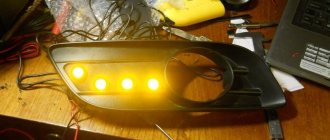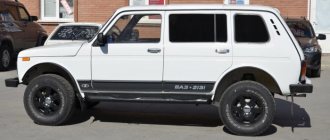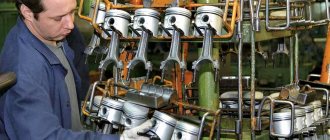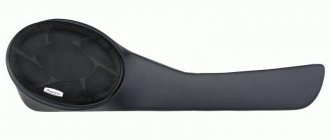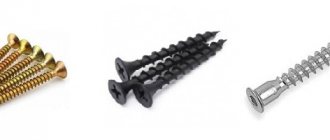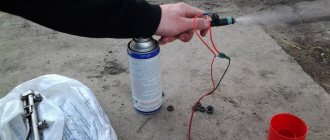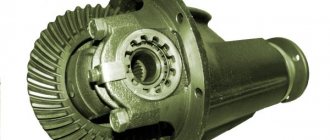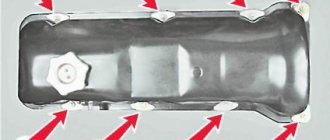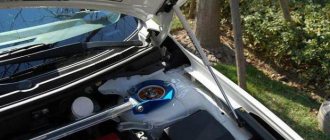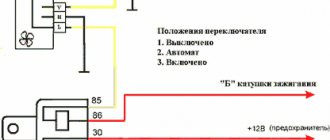Is it worth installing a self-locking differential on a Niva?
A differential is a device designed specifically to transmit the so-called torque from a car engine to its wheels using transmission elements. A free differential, installed on vehicles during assembly at the factory, cannot affect the other when one of the wheels slips. Differential locking can help achieve different wheel speeds when necessary (for example, on poor, usually dirt roads). It increases torque on one of the wheels, usually the one with the best traction. To achieve this result, a self-locking differential is used. An alternative option could be a forced blocking method. It is important to understand whether it is worth installing a self-locking differential on the Niva, what this will do for the car and how to carry out the installation of the device.
Differential lock on Niva (self-block): bringing the car to perfection
Today we will look at products that can qualitatively improve the Niva transmission. There are a huge variety of them on the market. We will try to clearly and intelligibly answer the question - which self-block is better to install on the Niva.
Content
- What are we dealing with?
- Coefficient, preload and other nuances
- Types of blocking on Niva
- Limited slip self-block (LSD)
- Forced blocking
- How to decide what to install?
What are we dealing with?
What is a differential or as it is sometimes abbreviated as “diff”. Why is it needed?! The Latin word “differentia” and the similar English word “different” are translated into Russian almost identically: “difference” or “different”. There is another definition of differential - planetary gear.
The purpose of this element is to transmit the power of the power unit through rotation without losing it on the axle shaft with the wheels attached to them. The differential causes them to rotate at different speeds depending on driving conditions. Inside a turn, the wheel makes much fewer revolutions than one that goes along a long radius. If in place of the “planetary” there was an ordinary solid axle, the probable parasitic circulation of power would guarantee a decrease in control over the car, loss of traction with asphalt, significant wear of the transmission, incredible fuel consumption, etc. The differential “links” the drive of one axle, removes the “parasitic” phenomenon, without loss of power.
An interwheel differential is present in almost all cars. It is usually located on the drive axle. There may be two or more axes to which the planetary gear distributes the incoming power flow.
Coefficient, preload and other nuances
The Niva 2121 is equipped with permanent all-wheel drive, and therefore, in addition to two inter-wheel differentials, it has a third - an inter-axle differential, distributing the moment between the front and rear.
A regular “free” differential is not always enough for a Niva owner. An SUV is bought to drive like a mother-in-law on different terrain and surfaces: dirt, snow, ice, etc. Often a car ends up with two wheels on a grippy surface and the other side on a slippery texture. In such a situation it is easy to “lose” him. Blocking will allow you not to worry about this.
When choosing a block, you need to take into account two important points - blocking coefficient and preload. The first denotes the ratio of torque on the lagging wheel with good grip and on the leading wheel, which has already lost contact with the road. A free differential has a coefficient of 1. For self-locking ones, it is up to five. That is, the lagging wheel will receive 5 times more torque. This parameter is sometimes indicated in %. For worm gears it is determined by the inclination of the teeth, for disk drives it is determined by the configuration of the friction clutches.
And preload is a certain moment of blocking inside the body of the product even before the moment when it may be required. Mostly in modern self-blocks, preload is created by washers. It can be customized to suit almost any driver's requirements. The washers can be replaced as they wear out, and the differential will continue to serve faithfully for many more years. While the teeth of the “worm” and the clutches of the “disc” design wear out sooner or later, the preload decreases.
Why do you need a self-block for Niva?
The presence of all-wheel drive in a car does not always give it the status of an all-terrain vehicle. Sometimes, due to the nature of their design, vehicles designed for off-road driving can become trapped on washed out roads. A self-locking differential is an important component of the car if the driver plans to use his Niva to drive on bad roads.
What is a self-block, or limited slip differential? This is a device that ensures wheel locking, and automatically, at the right time. It is an intermediate option between a full lock and a free differential. The self-block combines the capabilities of both of these devices.
Types of mechanisms
There are two main types of self-locking differentials, which include several more subtypes. The first type is devices that lock depending on the angular velocities on the vehicle axles. They can be:
The second type is mechanisms that lock depending on the torques on the axes. These include worm differentials.
There are also center and cross-axle differentials. They involve the distribution of torque between the axles and wheels, respectively. Depending on the moment of distribution attributable to the axles or wheels, symmetrical and asymmetrical types of mechanisms are distinguished. On vehicles called all-wheel drive, three types of differentials are installed at once: two of them are interwheel, and one is interaxle.
On the Niva it is possible to install electronic, mechanical (it is a conventional mechanism combined with a viscous coupling), and pneumatic differentials.
The electronic self-block has a very big advantage. To use it, just press a button. It works in automatic mode, but only when the car is traveling at a certain speed, which is below a threshold value. The system turns off when the speed exceeds the set speed.
The pneumatic differential is a mechanism mounted on two axles. The advantage is compactness. In its work it uses pneumatic systems.
The mechanical self-block is the simplest in its design; it is cheaper than pneumatic and electronic devices. The mechanism consists of two semi-axial and two spacer couplings, pins and springs. Quite a reliable design, despite its simplicity.
Varieties
There are two main groups of self-locking differentials. The first type works depending on the angular speed parameters along the axes of the vehicle. In turn, these modifications are divided into several subtypes, namely:
The second type includes mechanisms that are locked in accordance with the torsional moments on the axes. This group includes worm modifications.
In addition, there are inter-axle and inter-wheel self-blocks. With their help, torque is distributed between axles or wheels, respectively. The design of the mechanism, which can be symmetrical or asymmetrical, directly depends on the moment of force dispersion. On all-wheel drive SUVs, three sets of differentials are installed simultaneously, two between the wheels, one between the axles.
Characteristics and selection rules
The choice of a self-locking differential is determined by the car model, its operating conditions, driving style and many other parameters. For example, a ball differential increases steering load, which actually changes the driving style of whoever is behind the wheel. This is mainly felt when making U-turns and turns, but can lead to breakdowns of transmission components.
If you approach the choice of a self-block correctly, then you need to take into account which axle of the car the mechanism will be installed on, since the number of splines for different models is different - twenty-two or twenty-four.
The marking on the device packaging will tell you whether it can be used for a given car brand. The blocking coefficient also varies: for example, 0.5 or 0.7. These numbers show the amount of torque transmitted. What to choose is up to the driver.
DIY self-block installation instructions
To install a self-locking differential on a Niva, it is not necessary to contact a car service center. It is quite possible to do this with your own hands, provided that the person has a good understanding of the structure of the car. The type of differential and its installation location are not particularly important.
First you need to decide on the place where the work will be done; it should be spacious enough. Using several jacks, you will need to lift the Niva, dismantle the wheels, then drain the engine oil from the gearbox housing into some container and remove the drive axle drive. To do this, just use a spanner to unscrew all the nuts securing the front cover to the gearbox housing, remove the cover and gasket.
Now it is necessary to reliably and efficiently carry out the operation of dismantling the axle shafts, which is very difficult to do without a special puller. The metal is clamped on rotary slots, which requires a lot of effort, which not every person has enough. Dismantling the axle shafts is carried out as follows:
Then you need to change the bearings. This will require a hydraulic press. It will help ensure that the holder fits onto the shaft, and with fairly high accuracy. To replace you need:
After the clearances in the main gear are adjusted using special washers of variable thickness, you can begin assembling the unit. Adjusting the gaps is quite difficult, and you will need special equipment, but to ensure accuracy you can use a steelyard. To work with it, wind one end of a 1 m long cord around the flange and secure the other end to the scales. By pulling the device in the winding, you will need to record the turning moment.
To ensure proper operation of the gearbox, the parts are usually sealed before the halves are assembled. In its absence, malfunctions may occur during operation, as well as failure of certain spare parts. After applying the sealant, you need to wait a while for it to harden. Then new oil should be poured into the gear housing. All sealing joints that were damaged during dismantling, as well as those that show signs of oil leakage, must be completely replaced with new ones. Now you can start assembling all the mechanisms in reverse order.
After completing all the replacement and installation of parts, you must check the operation of the devices that provide vehicle braking. Their malfunction may affect road safety.
The feasibility of such an action as differential locking on a Niva depends on why the driver needs it. If you need to move through difficult areas, you will need it. If a car enthusiast intends to drive on a normal asphalt road, then installing a self-locking differential on the Niva is hardly worth it. Which self-block to choose and where to place it depends on the driver’s preferences.
Source
Assembly of the unit
When you have decided on the best self-locking differential for the Niva, you can begin assembling the unit. Initially, they adjust the gaps, which is not so simple. For this purpose, special washers of different thicknesses are used. Alternatively, accuracy is determined using a steelyard. One edge of the cord (about a meter in length) is wound around the flange, and the second is fixed to the scales. Pull the device in the winding, not forgetting to mark the turning point.
To ensure correct functioning of the gearbox, the elements are sealed before assembling the parts. If this is not done, soon after installation defects may appear, even to the point of complete breakdown of some parts. After treating the surfaces with sealant, wait until it dries completely. Next, the gearbox is filled with new oil. All sealing components with deformations and a hint of leakage are replaced. The mechanisms are assembled in a mirror order. After the replacement and installation of parts is completed, you should check the operation of the brake unit. This is very important, since malfunction of parts affects road safety.
Self-locking differential on Niva: is it worth installing?
Niva car is a type of off-road vehicle. This car is designed for driving on not the best sections of the road, off-road.
What is a limited slip differential?
A self-locking differential is a device based on a screw design. Increases the cross-country ability of vehicles, in particular such as Niva. When installing a differential, the car can easily overcome difficult sections of the road and terrain where driving is difficult. Therefore, installing a “self-block” on a Niva increases and improves the capabilities of this machine.
Center lock
There are devices that are designed only for off-road vehicles. They are not installed on cars for normal city driving. One of these “helpers” is the Center Differential. It distributes movement across axes. Its purpose is to transfer the rotating movement of one source to others . That is, if the rear or front wheels slip and the car cannot move, then the driving dynamics are distributed to all wheels. The operation of the center lock is based on a simple principle - the torque (rotation of the wheels) is divided between the front and rear axles . This effect makes it possible for the car to continue moving. Agree that this is a very good invention for cars - SUVs, which also includes the Niva.
Single axle locking – cross-axle
Cross-wheel locking of one axle is another function of a self-locking differential. To drive through difficult terrain, axle locking will undoubtedly be necessary. But often this is not enough. And there is a need to increase the power of the machine. It is in this case that you need to use inter-wheel locking of one axle.
The axle lock can be forced by the driver.
It can also be automatic. When one of the wheels slips
, the locking function is activated.
The principle of operation is the transmission of rotational motion exactly where the load is least .
If the “self-block” is installed on the front axle, it is possible to enable inter-wheel locking. If on the rear axle, then on the rear axle there is the same possibility. Interaxle locking switches movement from the front axle to the rear and vice versa, and interwheel locking transfers torque between the wheels on a certain axle . The inter-wheel locking can automatically turn on itself, if necessary. During normal driving, the differential operates in classic mode.
The question arises,
on which axle is it more advisable to install a self-locking differential
, on the front or on the rear?
Motorists have differing opinions on this. Some recommend the rear axle, others vice versa. If you are afraid of getting stuck on the road or problem area, especially due to adverse weather conditions, you can install a “self-block” on the front and rear axles . This will give you confidence, and if the car gets into a difficult section of the road, all wheels will work perfectly!
What types of self-locking differentials are there for the Niva?
A self-locking differential can be selected for any make of car. They are available for both domestic and foreign cars.
If we objectively characterize the types and principles of operation of differentials, then they can be divided into three types :
1. Locking differential
, which will turn on and occur when the movement accelerates.
2. Self-locking differential
, which functions when braking and accelerating the car.
3. Something in between the first and second types. When slowing down, there will be a smoother operating process.
Also defining names: gerotor differential, differential that is sensitive to the difference in rotational torques of movement, friction differential.
Perhaps, of these three types, the least desirable is friction . Why is it not as good as other types? Inside it, friction discs are located on the axle shafts. Fuel consumption when using it increases slightly, and the service life of the friction discs is short. Among the manufacturing companies that manufacture these devices, there are both foreign and domestic manufacturers. The choice depends on your preferences, car brand and characteristics.
Advantages and disadvantages of installation
The self-locking differential is a separate independent design. It is, of course, recommended that it be installed at a car service center. But if you have an understanding and knowledge of the device, the work and the car as a whole, then you can do the installation yourself.
Important points should be taken into account, including adjusting parts , determining marks and gaps, which not everyone can do accurately. Therefore, a qualified automotive service specialist can install the “self-block” at a professional level. It will be much more reliable than if you did this work yourself.
Owner reviews
From numerous reviews from motorists, you can always find important aspects. For example, regarding the installation issue - is it possible to install a differential on the front axle, or only on the rear? Regarding Niva cars, it can be installed on both axles .
The increase in cross-country ability from the front block is greater than from the rear one, since the front wheels have more load and are controlled. A helical self-locking differential is more reliable. For the Niva car, it is recommended to use not only reduced blocking , but also add center blocking. Thanks to this equipment, the car can cope even with ice and various types of severe off-road conditions.
